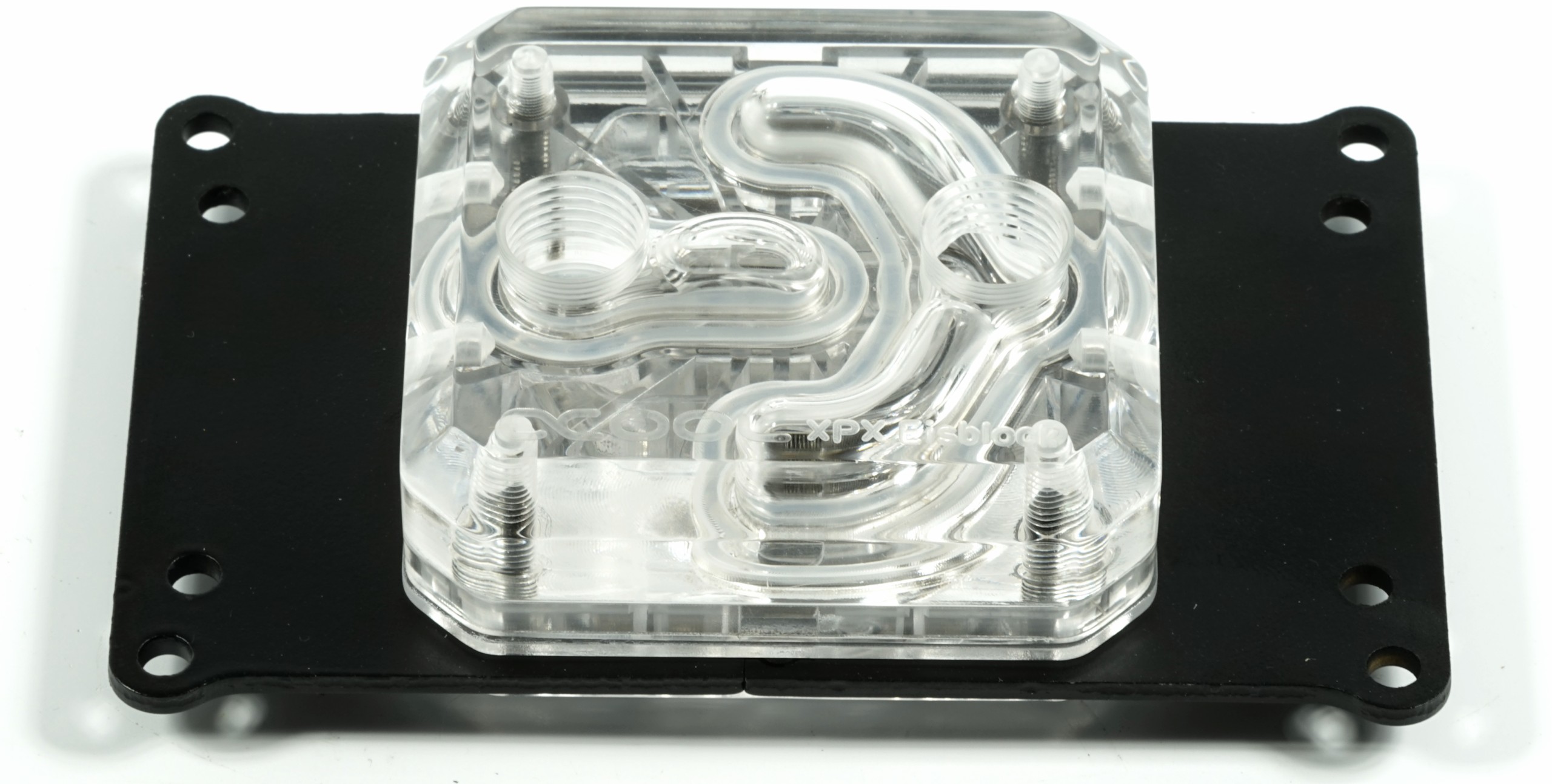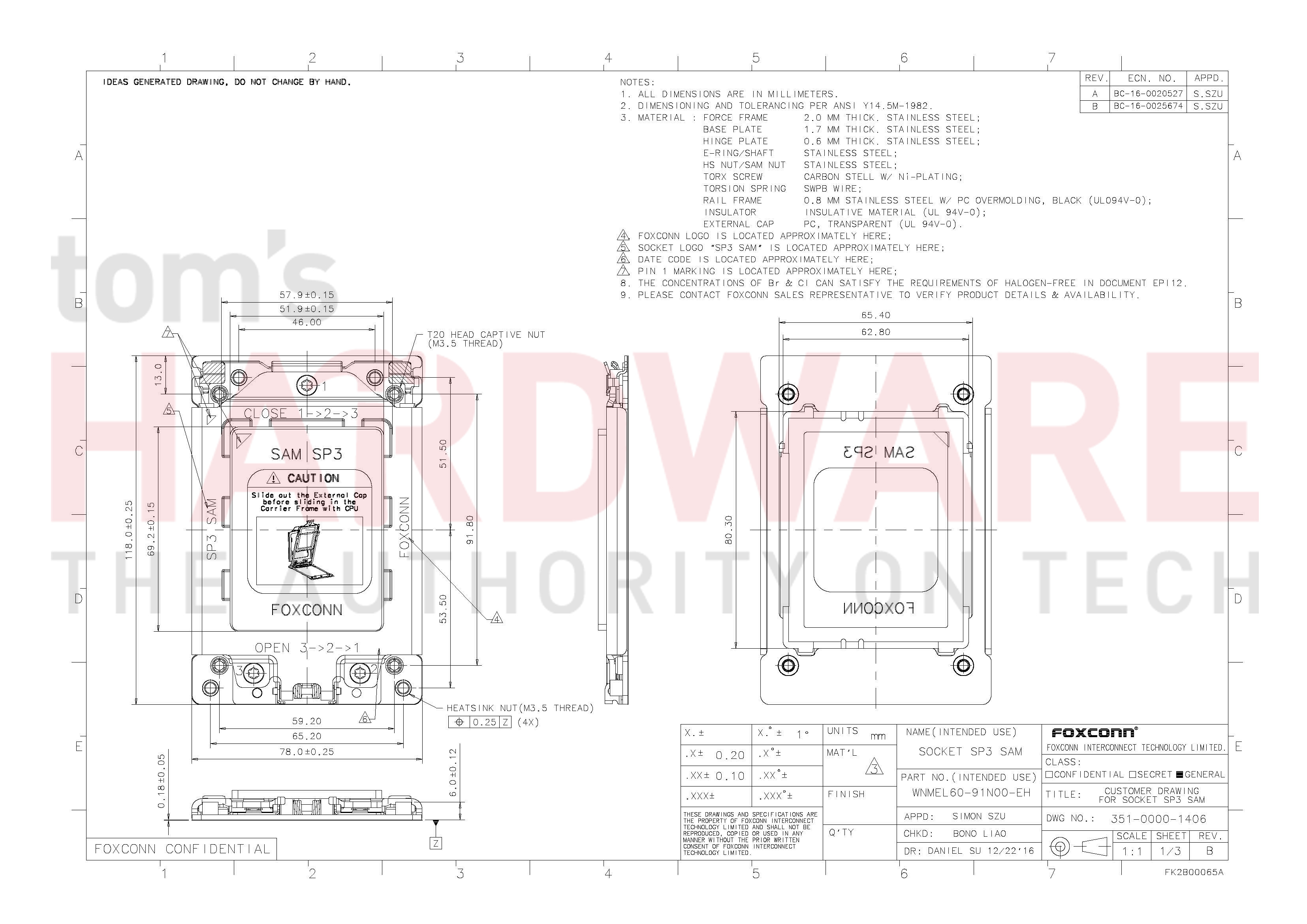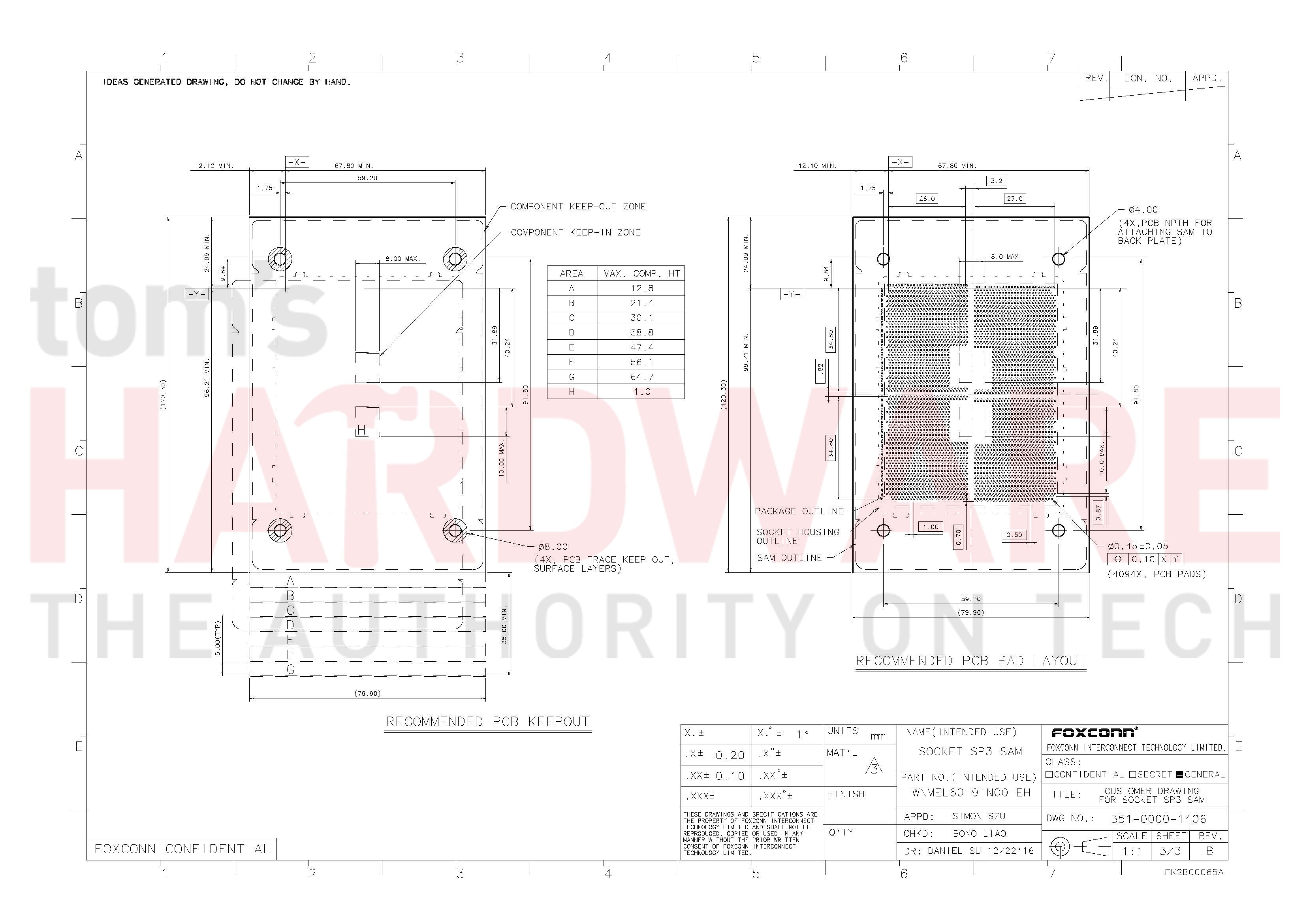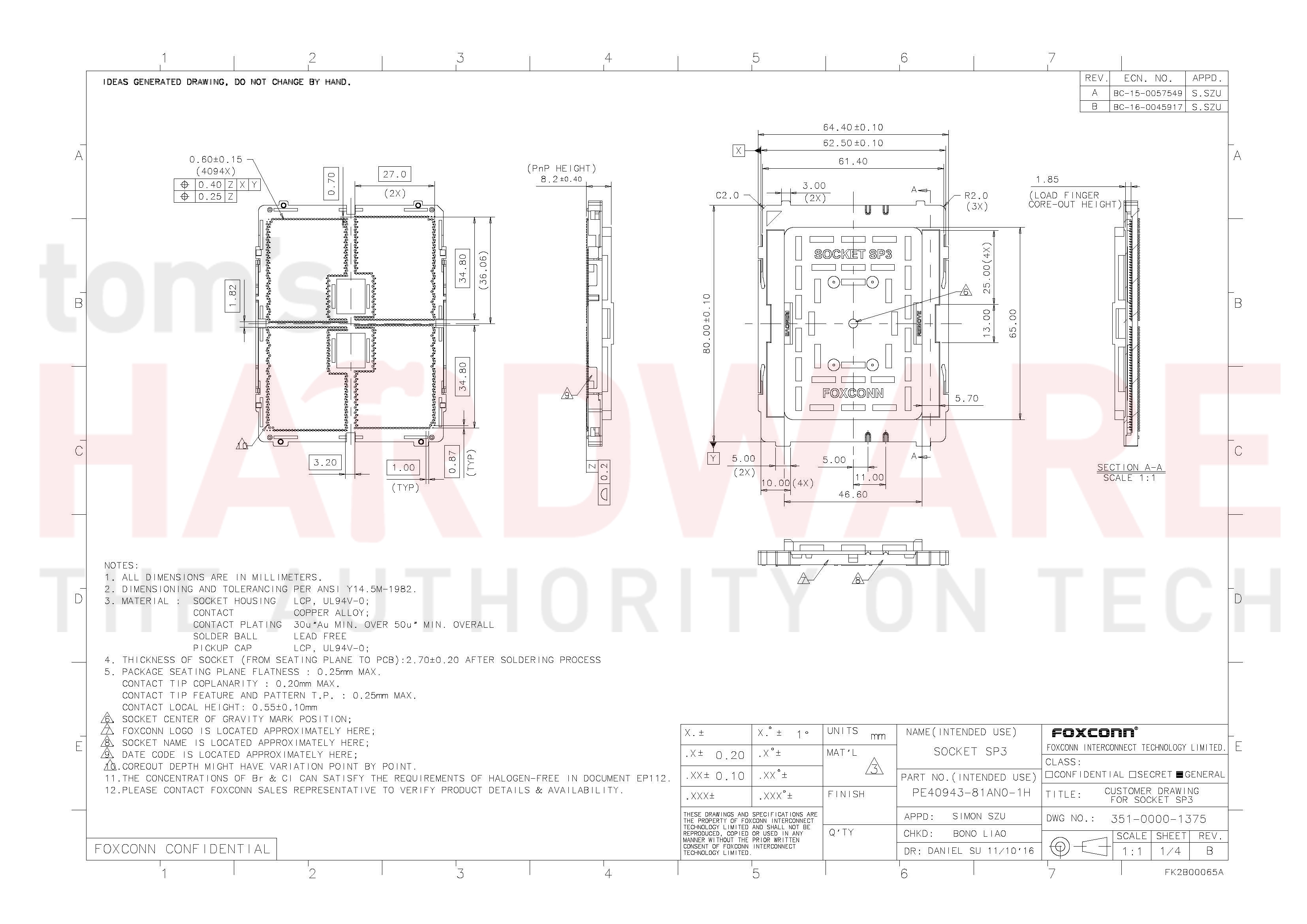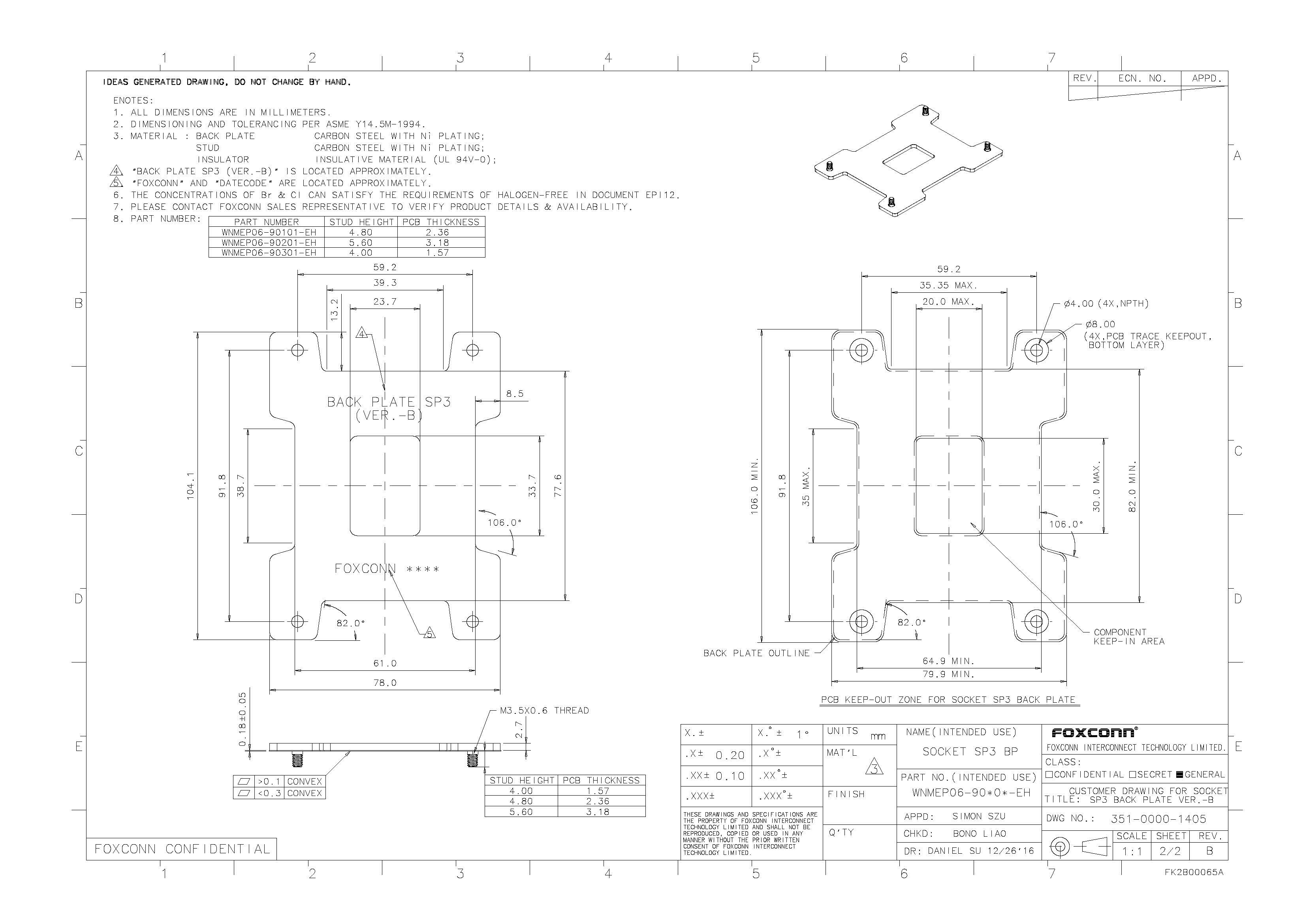Exclusive Threadripper Socket TR4 Schematics, Cooler Compatibility
AMD's 4,094-pin socket, which is paired with the X399 chipset for Threadripper, is massive by any measure. AMD christened it as Socket TR4 (SP3r2) for consumer motherboards and Socket SP3 for EPYC servers. The physical dimensions of both LGA (Land Grid Array) sockets are identical.
In either case, Socket TR4 far outweighs Intel's 2,066-pin socket for the X-Series platform, which has the natural side effect of a much larger heatspreader on the Threadripper processors. That presents challenges for cooler vendors, but AMD also uses indium solder under the heatspreader, which should help thermal performance significantly.
We know that AMD and various cooler manufacturers will be offering special solutions that will allow existing coolers to be used on AMD's much larger Socket TR4. We succeeded in obtaining a set of new adapters for the Alphacool XPX that we use in our German test lab. Please note that the manufacturer did not serve as a source for our exclusive schematics.
Since we now have the complete design drawings for the socket, we have superimposed the cooling solution over the socket schematic and made some educated guesses. This helps us to assess compatibility beforehand.
It's striking that, in addition to the rectangular shape of the CPU recess in the socket frame, there is an asymmetrical arrangement of the mounting screw emplacements. On the left, we see a distance of 65.2mm and to the right only 46mm. We also see very nicely where the modified square (or round heatsink) cooler will mount. A large, rather square waterblock, like the illustrated Alphacool XPX, should be an advantage over the round solutions we find on many of the Asetek products.
The rectangular heatsink covers about 90% of Threadripper's integrated heat spreader after accounting for the screws on the waterblock and the uncovered edges of the processor. Also, the arrangement and size of the microchannels inside the waterblock are, of course, not (yet) optimal. Threadripper CPUs have four die, and thus there are large disparate hotspots. This requires large-area microchannel fields and other flow profiles in the cooler.
For the launch, however, the water block should be sufficient, though it isn't perfect yet. We are curious when (and which) products will be specially adapted for the TR4/SP3r2 socket, and how much better they will perform.
Get Tom's Hardware's best news and in-depth reviews, straight to your inbox.
For those of you do-it-yourselfers with a CNC milling machine, or for those who are simply curious, we have compiled all of the relevant design documents and present them below.
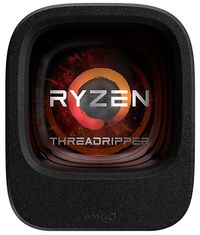
Socket SP3 front side

Igor Wallossek wrote a wide variety of hardware articles for Tom's Hardware, with a strong focus on technical analysis and in-depth reviews. His contributions have spanned a broad spectrum of PC components, including GPUs, CPUs, workstations, and PC builds. His insightful articles provide readers with detailed knowledge to make informed decisions in the ever-evolving tech landscape
-
Obviously Tony Danza These are really horrible drawings, per ASME Y14.5... It's almost like they have no idea how GD&T works...Reply -
FPS-fan I'm just a humble home computer builder and will never have a need for one of these monsters. However I saw the three letters LGA and shuddered. My experience with LGA hasn't been great having bent socket pins in a build, thankfully only the once, and of course thinking to myslef: "How stupid am I!"Reply
Hopefully the following link is viewable. Have a look at the bent pins in the image of a TR4 socket motherboard: http://www.pcworld.com/article/3197184/components-processors/amd-ryzen-threadripper-prices-specs-release-date-and-more.html
I'm glad I didn't do it! And perhaps I'm not as stupid as I originally thought.
For me personally, any future builds will utilize the AM4 socket simply because I can't guarantee robot precision that seems to be needed when installing the cpu. -
Paul Alcorn Reply19991624 said:I'm just a humble home computer builder and will never have a need for one of these monsters. However I saw the three letters LGA and shuddered. My experience with LGA hasn't been great having bent socket pins in a build, thankfully only the once, and of course thinking to myslef: "How stupid am I!"
Hopefully the following link is viewable. Have a look at the bent pins in the image of a TR4 socket motherboard: http://www.pcworld.com/article/3197184/components-processors/amd-ryzen-threadripper-prices-specs-release-date-and-more.html
I'm glad I didn't do it! And perhaps I'm not as stupid as I originally thought.
For me personally, any future builds will utilize the AM4 socket simply because I can't guarantee robot precision that seems to be needed when installing the cpu.
Good eye! Those look familiar. I've killed boards that way before, one even recently. I can swap eight procs in for a single test cycle, so it's just the odds, I guess.
-
P1nky "Threadripper CPUs have four die, and thus there are large disparate hotspots."Reply
Only 2 dies are working, confirmed by der8auer and Ian Cutress from Anandtech after speaking with AMD representatives. -
FormatC I wrote in original not four, but "few" (small but fine difference), because nothing is confirmed yet oficially. BTW: this delidded CPU was a very, very early sample, older than the first working ES.Reply
But it is not clear, which of them will work and which not and it might be in each CPU totally different. So all cooler vendors must plan with the worst case and use the cooling area for all four dies. :) -
g-unit1111 I can't believe anyone would cool a $1,000 CPU with anything less than a full custom water block. If you do, you're doing it wrong.Reply -
rwinches Full Quote from Ian Cutress.Reply
"Stories about TR having four dies. Confirmed two dies are disabled, and it's an ES - not final retail packaging. Could still end up 2"
So we have to see if a production TR have the same setup. Doesn't seem to make sense with multiple dies. -
Paul Alcorn Reply19995290 said:Full Quote from Ian Cutress.
"Stories about TR having four dies. Confirmed two dies are disabled, and it's an ES - not final retail packaging. Could still end up 2"
So we have to see if a production TR have the same setup. Doesn't seem to make sense with multiple dies.
AMD will have to keep four emplacements in the package to ensure that pressure from heatsink pressure does not result in crushing the IHS. If there are missing packages the IHS could bow in those areas.
These other two Zeppelin die are likely 'dummy' die to avoid this issue. As such, it's possible those die on his sample are not 'real' die at all. AMD will also likely keep solder across the entire package, as well, to ensure consistent thermal dissipation.
-
bit_user ReplyIt's striking that, in addition to the rectangular shape of the CPU recess in the socket frame, there is an asymmetrical arrangement of the mounting screw emplacements. On the left, we see a distance of 65.2mm and to the right only 46mm.
The two distances you quote are measuring different things. I think those holes are symmetrical, which they're taking advantage of in order to alternate which distances they list on each side, in order to keep the diagram from being too cluttered.
